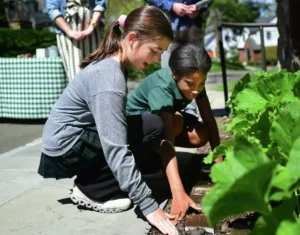By Sydney Boyo on NBC Connecticut on May 3, 2024
Witness Stones
The Witness Stones Project Unearths and Shares Stories of Northern Slavery
By Diane Orson on May 1, 2024 on NPR’s All Things Considered
For centuries, stories of northern slavery were not easy to find. Understanding slavery in this project involves learning the stories of those enslaved — and bearing witness.
We invite you to listen to this NPR story about how the Witness Stones Project is recovering our history.
Greenwich Students Unearth History of 4 More of Town’s Enslaved People for Historical Markers

By Robert Marchant on April 27, 2024 in the Greenwich Time
GREENWICH — The lives of enslaved laborers who toiled on the fields, stables and kitchens of Greenwich in the 1700s and 1800s has been obscured for centuries, but remnants of their lives are slowly being recovered and marked thanks to the work of local educators, researchers, students and the Greenwich Historical Society.
The team effort is creating markers, called “Witness Stones,” for enslaved men and women, and four more of the stones were placed on the grounds of the Bush-Holley House, the campus of the historical society, on Friday during a brief ceremony attended by students.
Slavery was widely practiced all over Connecticut. It was not fully abolished in the state until 1848, following a gradual emancipation law that freed slaves when they reached the age of 25, later amended to 21. Connecticut permitted slavery long after New York state and Massachusetts had ended the practice.
Sophomore high school students from Greenwich Academy and seventh graders from Sacred Heart Greenwich helped research the lives of the four enslaved men and women featured on the new Witness Stones.
Chloe Cernigilia, a student at Greenwich Academy, said tracing the journey of a young woman who born into slavery in southern Connecticut and later escaped to Canada to live as a free woman awakened a fascination with history.
“I loved this project. It was so interesting, to connect history to one person,” she said.
Cernigilia and other Greenwich Academy students researched the life of Dorcas Scudder, one of of the 16 known enslaved individuals held by the Bush family. The Bush family of early Greenwich came from Holland and originally carried the surname Bosch. They were unrelated to the family of Presidents George and George H.W. Bush of Greenwich.
Dorcas Scudder, born in 1763, ran away to join the British and loyalist forces in the region as a teenager, under a promise of freedom to enslaved men or women who joined their cause. She appears to have died during a time of intense deprivation in the town where she settled in Canada in 1785.
Speaking of Dorcas Scudder, Cernigilia said she was impressed how she “paved her own way to liberation,” and that her story demonstrated “how individuals responded to the dehumanizing environment they were forced to survive.”
The project also brought to light and markers for Nanny, born in 1798 and emancipated in 1819; Lucy, born in 1795 and emancipated in 1816; and Peggy, born in 1780 and whose fate is unknown. The student-researchers noted that very little information was recorded for enslaved men and women, so the historical record was scant, and their surnames are unknown.
Claire Ryan, a student at Sacred Heart, said it struck her how Nanny’s family was broken up in the 1790s. Nanny may never have seen her four siblings again after they were sent out to serve in other households once they reached an age when they were old enough to work independently.
The Witness Stones Project is an organization founded by a Guilford history teacher. It has been commemorating the lives of enslaved people in the Northeast with memorial markers beginning in 2017. A total of 14 stones have been placed so far at Greenwich historical society land.
Teresa Vega, a researcher and historian who is related to a number of African American early inhabitants of Greenwich, encouraged the students to keep developing an interest in the past.
“The more you find, the more questions you ask, and there’s so much in the archives waiting to be discovered,” she said. “You can be rich in terms of history and knowledge. Keep doing what you’re doing.” Link to full article with photos


